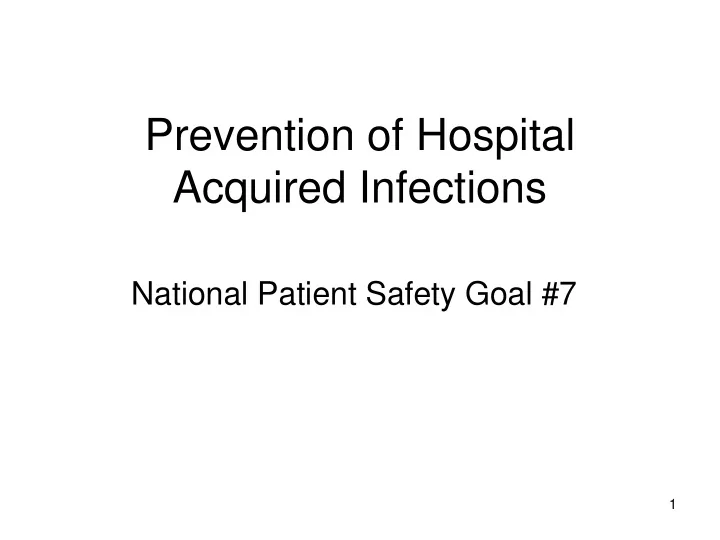

Prevention of Hospital Acquired Infections National Patient Safety Goal #7 1
Course Goals After completing this course, you should be able to: 1. Name 3 basic principles of infection prevention. 2. Name 2 MDRO’s seen at the hospital 3. State the 5 elements of the Central Line Associated Bloodstream Infection Prevention Bundle 4. Name two methods to prevent Surgical Site Infections 2
Infection Prevention Starts with the Basics • Hand Hygiene is the single most important method to prevent the spread of germs. – Use alcohol gel or soap and water • Use Standard Precautions for all patient care – Hand hygiene, appropriate personal protective equipment based on anticipated exposure to blood or body fluids (gloves, gowns, eyewear) • Respiratory Etiquette/Hygiene for all – Cover that cough – If unable to cover cough, use a surgical mask • Clean the environment using a hospital- approved disinfectant 3
Multi-Drug Resistant Organisms (MDRO’s) • When organisms become resistant to many of the antibiotics usually used for treatment, they are called MDRO. • Examples of MDRO’s include: – Methicillin Resistant Staph Aureus - MRSA – Vancomycin Resistant Enterococcus - VRE – Clostridium difficile – C. diff 4
Contact Precautions • Contact Precautions are used to reduce the transmission of MDRO’s • Purple Contact Precaution sign • All Contact Precautions rooms use bleach protocol for cleaning • Must wear gown and gloves upon entry into the room • Have dedicated equipment kept in the room • Private room 5
Isolation Signs CONTACT PRECAUTIONS Bleach Protocol When Patient Discharged WHEN YOU ENTER THE ROOM, EVEN IF YOU ARE NOT GOING TO BE IN DIRECT CONTACT WITH THE PATIENT OR EQUIPMENT, YOU MUST : 1. WEAR GLOVES 2. WEAR A DISPOSABLE GOWN 3. WASH HANDS WHEN YOU ENTER AND LEAVE THE ROOM 100-1284 (7/08) 6
7
8
Patient-Centered Education • “We Care” poster/handout provides the patient and/or family with information regarding infection control measures for hand hygiene practices, respiratory hygiene practices and contact precautions according to the patient’s condition. • The information is discussed with the patient and family on the day patient enters the hospital, or as soon as possible (for example, within 24 – 48 hours). • The patient’s understanding of this information is evaluated and documented in clinical CIS. • The information provided to the patient may be in any form of media. 9
10
Prevention of Central Line Associated Blood Stream Infections (CLABSI) • The use of the Central Line Bundle has shown to decrease the incidence of CLABSI. – Compliance with hand hygiene – Use of maximal barrier precautions (large drape, gown, mask, gloves, cap) – Use of 2% chlorhexidine solution for skin antisepsis – Selection of optimal site for the catheter – Daily review and documentation of the need for the line, with prompt removal if line is deemed unnecessary 11
Prevention of Surgical Site Infections (SSI) • Preoperative – Administer the correct prophylactic antibiotics at least 15 minutes prior to incision but NO greater than one hour. – Use clippers instead of razors if hair removal is needed – Make certain patients shower or bathe with Chlorhexidine gluconate (CHG) on at least the last night before surgery – Use only hospital-approved antiseptic agent for skin preparation 12
Prevention of Surgical Site Infections (SSI) • Intraoperative – Traffic control – limit number of personnel in room and keep door closed • Postoperative – Protect a closed incision for 24-48 postoperatively with a sterile dressing – Wash hand before and after dressing changes, and any contact with the surgical site – Maintain adequate glycemic control 13
Prevention of Catheter Associated Urinary Tract Infections (CAUTI) • Limit use and duration of indwelling urinary catheters • Insert urinary catheters using aseptic technique – One attempt at insertion allowed for each catheter • Secure catheters for unobstructed urine flow and drainage – Statlock required to reduce pistoning and tension • Keep tubing off floor and without dependent loops • Maintain sterility of the urine collection system • Use one urinal/cylinder for each patient to empty collection bag • Do not allow bag drain spigot to touch the floor • Replace urine collection system when required • Provide gentle perineal care daily and as needed • Clean catheter tubing at perineal area at least daily and as needed with soap and water • Collect urine samples aseptically via sample port • Aggressively scrub sample port with alcohol swab prior to obtaining sample 14
Additional Information • For information about isolation and precautions, infection prevention practices, the Infection Control Manual is available on the intranet under policies/infection control manual. http://portal.stanfordmed.org/policies/infectionco ntrolmanual/Pages/default.aspx 15
16
Recommend
More recommend